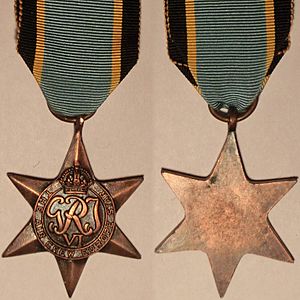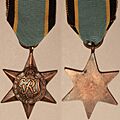Air Crew Europe Star facts for kids
Quick facts for kids Air Crew Europe Star |
|
|---|---|

Obverse and reverse of the medal
|
|
| Country | |
| Type | Military campaign medal |
| Eligibility | Pilots and flying crew |
| Awarded for | 60 days operational flying |
| Campaign(s) | European Air Operations 1939–1944 |
| Clasps | ATLANTIC FRANCE AND GERMANY |
| Statistics | |
| Established | May 1945 |
| Order of wear | |
| Next (higher) | Arctic Star |
| Next (lower) | Africa Star |
| Related | Atlantic Star France and Germany Star |
Ribbon bar without and with rosette |
|
The Air Crew Europe Star is a special military medal. It was created by the United Kingdom in May 1945. This medal was given to air crews from Britain and other Commonwealth countries. They earned it for flying important missions over Europe during World War II. These flights took off from bases in the United Kingdom.
Two special bars, called clasps, could be added to the medal's ribbon. These were named Atlantic and France and Germany.
Contents
Understanding World War II Medals
During World War II, many different medals were created. These were called "campaign stars." They honored soldiers, sailors, and air crews for their service in different battles and areas. The first two stars were created on 8 July 1943. By May 1945, there were eight stars and nine clasps. Later, in 2013, two more were added.
How Many Stars Could Someone Get?
A person could receive a maximum of six campaign stars. If someone earned a second star for a similar campaign, they would usually get a clasp instead. Only one clasp could be worn on any single campaign star.
- The 1939–1945 Star was for service throughout the war. It could have a clasp for the Battle of Britain or Bomber Command.
- You could only get one of these three: the Atlantic Star, the Air Crew Europe Star, or the France and Germany Star. If you qualified for more than one, you received the first one you earned. The others were shown as clasps on that medal's ribbon.
- The Arctic Star was for dangerous convoys to the Soviet Union.
- The Africa Star was for service in the North African Campaign. It could have clasps like "North Africa 1942–43."
- You could get either the Pacific Star or the Burma Star. If you earned both, the second was shown as a clasp.
- The Italy Star was for service in the Italian Campaign.
Everyone who received a campaign star also got the War Medal.
Clasps for the Air Crew Europe Star
Because you could only get one of the Atlantic, Air Crew Europe, or France and Germany Stars, clasps were used.
- If you had the Atlantic Star, you might get an Air Crew Europe or France and Germany clasp.
- If you had the Air Crew Europe Star, you might get a France and Germany or Atlantic clasp.
- If you had the France and Germany Star, you could get an Atlantic clasp.
Why Was This Medal Created?
The Air Crew Europe Star was created in May 1945. It honored air crews who flew important missions over Europe. These missions were part of the strategic bombing campaign against Germany. This campaign helped the Allies win the war. The Royal Air Force faced many dangers and lost many planes and people.
This medal was specifically for air crews. It was not given to ground crew who supported the flights.
Clasps and Medal Rules
The two clasps for this medal are 'Atlantic' and 'France and Germany'. British rules said that a person could only wear one clasp on any campaign star. If you received the Air Crew Europe Star, you would not also get the Atlantic Star or the France and Germany Star. Instead, if you qualified for those, you would receive the correct clasp to wear on your Air Crew Europe Star. Only the first clasp you earned was worn.
Who Earned the Air Crew Europe Star?
General Rules for Award
The Air Crew Europe Star was given for flying missions over Europe. These missions took place from 3 September 1939 (when World War II started) to 5 June 1944 (the day before D-Day).
- For Royal Air Force air crew, you needed two months of operational flying to qualify.
- Army personnel on air crew duties needed four months of service. At least two of these months had to be operational flying over Europe. They also needed at least one operational flight.
- You had to have already earned the 1939-1945 Star before your service counted for the Air Crew Europe Star.
After D-Day (6 June 1944), flying over Europe qualified air crew for the France and Germany Star. If they already had the Atlantic Star or Air Crew Europe Star, they would get the France and Germany Clasp instead.
Special Ways to Qualify
Sometimes, you could get the Air Crew Europe Star faster.
- If you earned a bravery medal or were Mentioned in Dispatches for action during a flight over Europe, you got the Star right away. This was true no matter how long you had served.
- If your service was cut short because you died, became disabled, or were wounded due to your service, you also received the Star. This was also true regardless of how long you had served.
What Does the Medal Look Like?
The Air Crew Europe Star is one of nine campaign stars. They were all designed by engravers at the Royal Mint. These stars have six points and are made from a yellow copper zinc alloy. They are about 44 millimeters wide and 50 millimeters tall.
- Obverse (Front)
The front of the medal has a central design. It shows the Royal Cypher "GRI VI," which stands for King George VI. A crown sits above this. A circle around the cypher says "THE AIR CREW EUROPE STAR."
- Reverse (Back)
The back of the medal is plain.
- Naming the Medals
Most British forces' World War II medals were not named. However, medals given to people from India, South Africa, and Australia had the recipient's name stamped on the back. For South Africans, it included their service number, initials, and last name.
- Clasps
The clasps are made of bronze. They have a special edge that looks like a postage stamp. They are marked "ATLANTIC" or "FRANCE AND GERMANY." These clasps were sewn onto the medal's ribbon. Remember, only one clasp, the first one earned, could be worn with the Star. If someone wore just the ribbon (without the medal), a small silver rosette was added to the ribbon bar to show they had earned a clasp.
- Ribbon
The ribbon is 32 millimeters wide. It has a 4-millimeter black band, a 3-millimeter yellow band, an 18-millimeter blue band, and then the yellow and black bands repeated. The colors tell a story:
- The blue center stands for the sky.
- The black bands on the edges represent night flying.
- The yellow bands represent enemy searchlights.
This design shows the Royal Air Force's continuous service, day and night.
King George VI himself designed the ribbons for most of the World War II campaign stars, including this one.
How Medals Are Worn (Order of Wear)
Medals are worn in a specific order. For the World War II campaign stars, the order was decided by when each campaign started and how long it lasted. This order is followed even if a person earned them in a different sequence. The Defence Medal and War Medal are worn after the stars.
Here is the order for the main World War II medals:
- The 1939–1945 Star: For the entire war, from 3 September 1939 to 2 September 1945.
- The Atlantic Star: For service in the Battle of the Atlantic and the War in Europe, from 3 September 1939 to 8 May 1945.
- The Arctic Star: For service in the Arctic Convoys, from 3 September 1939 to 8 May 1945.
- The Air Crew Europe Star: For flights over Europe, from 3 September 1939 to 5 June 1944 (the day before D-Day).
- The Africa Star: For the North African Campaign, from 10 June 1940 to 12 May 1943.
- The Pacific Star: For the Pacific War, from 8 December 1941 to 2 September 1945.
- The Burma Star: For the Burma Campaign, from 11 December 1941 to 2 September 1945.
- The Italy Star: For the Italian Campaign, from 11 June 1943 to 8 May 1945.
- The France and Germany Star: For the North-West Europe Campaign, from 6 June 1944 to 8 May 1945.
- The Defence Medal: For home service and other duties, from 3 September 1939 to 8 May 1945 (or 2 September 1945 for those in the Far East).
- The War Medal: For service throughout the entire war, from 3 September 1939 to 2 September 1945.
The Air Crew Europe Star is worn after the Arctic Star and before the Africa Star.
Images for kids







